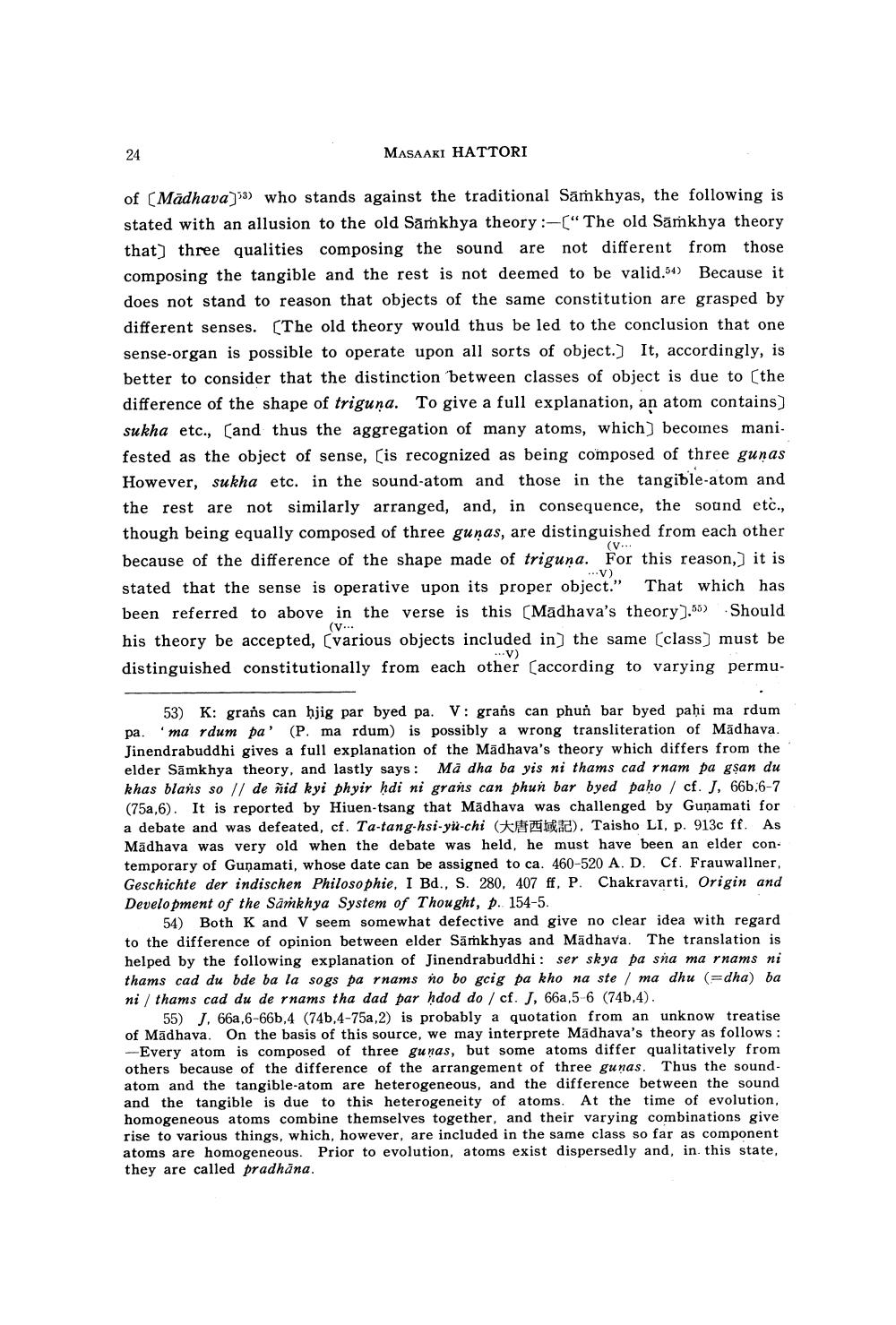________________
MASAAKI HATTORI
of (Madhava]") who stands against the traditional Sāmkhyas, the following is stated with an allusion to the old Samkhya theory :-("The old Samkhya theory that) three qualities composing the sound are not different from those composing the tangible and the rest is not deemed to be valid.54) Because it does not stand to reason that objects of the same constitution are grasped by different senses. (The old theory would thus be led to the conclusion that one sense-organ is possible to operate upon all sorts of object.) It, accordingly, is better to consider that the distinction between classes of object is due to (the difference of the shape of triguna. To give a full explanation, an atom contains) sukha etc., (and thus the aggregation of many atoms, which) becomes mani. fested as the object of sense, (is recognized as being composed of three gunas However, sukha etc. in the sound-atom and those in the tangible-atom and the rest are not similarly arranged, and, in consequence, the sound etc., though being equally composed of three guņas, are distinguished from each other because of the difference of the shape made of triguna. For this reason,) it is stated that the sense is operative upon its proper object." That which has been referred to above in the verse is this (Madhava's theory].55) Should his theory be accepted, various objects included in) the same (class) must be distinguished constitutionally from each other according to varying permu
V
V
53) K: grans can hjig par byed pa. V: grans can phun bar byed pahi ma rdum pa. 'ma rdum pa' (P. ma rdum) is possibly a wrong transliteration of Madhava. Jinendrabuddhi gives a full explanation of the Mädhava's theory which differs from the elder Sāmkhya theory, and lastly says: Ma dha ba yis ni thams cad rnam pa gşan du khas blans so // de ñid kyi phyir hdi ni grans can phun bar byed paho / cf. J, 666.6-7 (752,6). It is reported by Hiuen-tsang that Mādhava was challenged by Guņamati for a debate and was defeated, cf. Ta-tang-hsi-yü-chi (P d). Taisho LI, p. 913c ff. As Mādhava was very old when the debate was held, he must have been an elder contemporary of Gunamati, whose date can be assigned to ca. 460-520 A. D. Cf. Frauwallner, Geschichte der indischen Philosophie, I Bd., S. 280, 407 ff. P. Chakravarti, Origin and Development of the Samkhya System of Thought, p. 154-5.
54) Both K and V seem somewhat defective and give no clear idea with regard to the difference of opinion between elder Sāṁkhyas and MädhavaThe translation is helped by the following explanation of Jinendrabuddhi: ser skya pa sna ma rnams ni thams cad du bde ba la sogs pa nams no bo gcig pa kho na ste / ma dhu (=dha) ba ni / thams cad du de rnams tha dad par ḥdod do / cf. J, 66,5-6 (746,4).
55) J. 66a,6-66b,4 (74b,4-75a 2) is probably a quotation from an unknow treatise of Mādhava. On the basis of this source, we may interprete Madhava's theory as follows: -Every atom is composed of three gunas, but some atoms differ qualitatively from others because of the difference of the arrangement of three gunas. Thus the soundatom and the tangible-atom are heterogeneous, and the difference between the sound and the tangible is due to this heterogeneity of atoms. At the time of evolution, homogeneous atoms combine themselves together, and their varying combinations give rise to various things, which, however, are included in the same class so far as component atoms are homogeneous. Prior to evolution, atoms exist dispersedly and, in this state, they are called pradhana.




